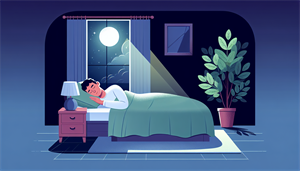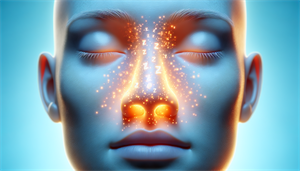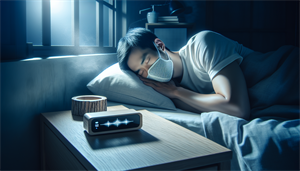Can sleep apnea cause dark circles under eyes? Yes, interruptions in sleep caused by this common disorder can leave you with substantial under-eye shadows.
Discover the reasons behind these unsightly dark circles and find out how managing your sleep apnea can help not only to improve your sleep but also to reduce the appearance of tired eyes.
Key Takeaways
-
Sleep apnea can cause dark circles under the eyes by leading to frequent sleep disruptions, fluid buildup, and reduced blood and oxygen flow, which result in exhaustion, puffiness, and dark circles.
-
Other medical conditions aside from sleep apnea that contribute to dark circles include allergies, heredity, hyperpigmentation, and various health issues, emphasizing the importance of addressing underlying causes.
-
Treatment for sleep apnea includes both home remedies, like changing sleep positions and addressing nasal congestion, and professional interventions, such as CPAP, with lifestyle changes also playing a critical role in symptom improvement.
Unveiling the Connection: Sleep Apnea and Under-Eye Circles

Sleep apnea, a sleep disorder marked by significant disruptions in breathing patterns, sometimes even leading to brief periods where the body completely stops breathing, is more common than you think. But what’s even more surprising is its connection to the dark circles under your eyes.
Yes, that’s right! Sleep apnea can cause those unsightly shadows to appear under your eyes, making you look tired even after you’ve spent a decent amount of time asleep. You may wonder how this occurs. Frequent sleep disruptions, a common symptom of sleep apnea, often result in fatigue. This exhaustion prompts fluid build-up under the eyes, leading to the development of dark circles and puffiness.
And here’s the kicker, even if you’re clocking enough hours in bed every night, undiagnosed sleep apnea could still be causing dark circles under your eyes. This is why treating sleep apnea is crucial not just for better sleep, but also for a fresher, brighter appearance!
The Breathing Barrier: How Stopped Breathing at Night Affects Your Eyes
What transpires when your breathing halts at night because of sleep apnea? The answer lies in the effect it has on the oxygen and blood flow to your eyes. Reduced oxygen and blood flow can lead to eye problems, including dark circles.
Sleep apnea, characterized by disrupted breathing during sleep, results in repeated periods of halted respiration. This leads to intermittent hypoxia and hypercapnia - conditions marked by low and high levels of carbon dioxide in the blood, respectively. These physiological changes can result in puffy eyes and dark circles.
Moreover, while melanin (the pigment that gives your skin its color) is the main factor influencing dark circles, oxygen saturation, and conditions impacting oxygen supply, such as anemia, can also play a part in the appearance of dark circles. Hence, it’s vital to take these underlying factors into account when tackling dark circles.
Daytime Fatigue and Its Visible Signs

Apart from the breathing issues at night, sleep apnea also leads to daytime fatigue. This fatigue, while not visible in itself, can manifest as dark circles and other signs on your face. Sleep deprivation, a common consequence of sleep apnea, can manifest as dark circles under the eyes, largely due to the fatigue from disrupted sleep.
Sleep deprivation can significantly impact your daytime sleepiness, affecting your:
-
Concentration
-
Cognitive ability
-
Ability to perform daily tasks
-
Ability to maintain focus
Moreover, a lack of sleep can worsen feelings of anxiety, making you experience heightened levels of anxiety compared to when you are well-rested.
Fortunately, regular and sufficient sleep can help diminish and potentially eliminate dark circles under the eyes. Establishing a consistent sleeping routine can help improve overall sleep quality.
Beyond the Surface: Medical Problems Linked to Dark Circles
While sleep apnea does play a significant role in the formation of dark circles, it’s worth noting that other medical conditions can contribute to this issue as well. For instance, allergies can cause irritation and inflammation of the eyes, leading to the growth of dark circles due to chronic eye rubbing and swelling.
Touching or rubbing the ocular area can worsen swelling and contribute to increased darkening of the under-eye area. This, coupled with the temporary relief from eye rubbing, can exacerbate the dark circles, creating a vicious cycle. One way to potentially reduce the dark circles caused by severe food and environmental allergies is by seeking treatment to address and manage the allergies.
Furthermore, factors such as:
-
heredity
-
hyperpigmentation
-
lack of sleep
-
liver disease
-
anemia
-
negative reactions to medications
Venous pooling can also contribute to the formation of dark circles under the eyes. This underscores the necessity of addressing both the symptoms and the underlying causes.
Diagnosing the Culprit: When to See a Healthcare Professional
So, when should you seek medical help? If you’re waking up with dark circles or bags under your eyes despite getting enough sleep, or if you’re feeling unrested after a night of sleep, it may be time to consult a healthcare professional.
Healthcare professionals diagnose sleep apnea by evaluating symptoms, conducting an exam, and performing tests, with attended polysomnography being considered the gold standard for diagnosis. If you suspect that your exhaustion and under-eye circles are caused by sleep apnea, it is advisable to consult a physician specializing in throat-related issues such as sleep apnea.
Keep in mind, prompt diagnosis and treatment of a medical problem can avert additional complications, greatly enhancing your quality of life and appearance.
Breathing Patterns and Nasal Health

Apart from the sleep disorder itself, the way we breathe also plays a crucial role in sleep quality and consequently, the appearance of our eyes. Nasal health has a significant impact on sleep quality. Issues like nasal congestion or sinus problems can cause breathing difficulties and snoring, increasing the chances of sleep apnea.
Typically, during sleep, individuals experience slow and consistent breathing patterns that become shallower. However, mouth breathing can interfere with this pattern, leading to potential sleep disturbances, dental and facial problems, and even contributing to conditions such as heart disease. In some cases, it may even cause an individual to momentarily stop breathing.
One simple change you can make to improve your sleep quality and reduce inflammation is to use lip-taping. Lip-taping promotes nasal breathing, which can result in:
-
Increased nitric oxide production
-
Enhanced sleep quality
-
Improved memory
-
Overall health benefits
Home Remedies vs. Professional Treatment for Sleep Apnea
While professional treatments for sleep apnea are available and effective, there are also several home remedies that can be helpful. Here are some effective home remedies for treating sleep apnea:
-
Changing sleep positions
-
Avoiding alcohol use
-
Exercising regularly
-
Discussing medication side effects with your doctor
-
Treating nasal congestion
-
Playing a wind instrument
These remedies can provide relief and improve sleep quality for individuals with sleep apnea.
On the other hand, professional interventions for obstructive sleep apnea such as:
-
Continuous positive airway pressure (CPAP)
-
Upper airway stimulation therapy
-
Oral appliance therapy
-
Surgery
have demonstrated effectiveness, with success rates ranging from 39% to 78%. This indicates that while home remedies can be helpful, professional treatments are often more effective.
That being said, there are no significant side effects associated with home remedies for sleep apnea, in contrast to the potential side effects that some professional treatments might carry. So, the choice between home remedies and professional treatment should be made based on individual needs and circumstances, preferably in consultation with a healthcare professional.
Lifestyle Adjustments for Better Sleep and Brighter Eyes
In addition to medical therapies and home remedies, lifestyle modifications can also make a substantial difference in improving sleep and reducing under-eye circles. Here are some lifestyle modifications that can help:
-
Engaging in relaxation techniques such as meditation and deep breathing
-
Refraining from consuming heavy meals late at night
-
Participating in regular physical activity earlier in the day
These modifications can enhance sleep quality.
Changing your diet can significantly improve sleep apnea symptoms. Losing weight, incorporating foods high in tryptophan, and adopting a healthier overall diet can reduce the severity of the condition. Regular exercise decreases body fat, particularly around the neck area, which can reduce airway obstruction and the severity of sleep apnea symptoms.
Also worth mentioning is the fact that alcohol, caffeine, and smoking can interfere with sleep patterns and exacerbate sleep apnea symptoms. These substances can also contribute to the development of dark circles under the eyes.
Success Stories: Patient Transformations After Treating Sleep Apnea
The process of treating sleep apnea may pose challenges, but the outcomes are frequently rewarding. After addressing sleep apnea, many patients have noticed the following improvements:
-
Enhancements in neurocognitive performance
-
Relief from insomnia
-
Decreased sleepiness
-
Better sleep quality
-
Cessation of excessive snoring
-
Improved attention
-
Improved daily functioning
In fact, researchers have found that patients appear more alert, youthful, and attractive in post-treatment photos. Additionally, the raters were able to correctly identify the post-treatment photo two-thirds of the time.
To bring this point home, let’s hear from Grace, who was fully cured of sleep apnea and experienced a significant improvement in her quality of life. “I now enjoy peaceful nights of sleep, free from the disruptions of snoring and other symptoms of sleep apnea,” she shares enthusiastically.
Summary
In conclusion, the connection between sleep apnea and under-eye circles is clear. By treating sleep apnea, not only can you improve your sleep quality and overall health, but you can also reduce the appearance of dark circles under your eyes. Various treatment options, both professional and home-based, are available to manage this condition.
Remember, sleep apnea is not just about getting enough sleep, it’s also about how you breathe while you sleep. So, if you’re dealing with persistent dark circles despite getting enough sleep, it might be time to consider sleep apnea as a potential cause and seek professional help.
Frequently Asked Questions
Can lack of oxygen cause dark circles under eyes?
Yes, a lack of oxygen can cause dark circles under the eyes by affecting the body's circulation and oxygen supply, leading to visible blood vessels and darkened skin under the eyes. Anemia, iron deficiency, liver problems, and medications that dilate blood vessels can also contribute to dark eye circles.
Can breathing problems cause dark circles?
Yes, breathing problems can cause dark circles under your eyes by leading to poor drainage of blood vessels and causing under-eye skin to appear darker.
What are dark circles under eyes a symptom of?
Dark circles under the eyes can be a sign of tiredness, lack of sleep, allergies, thyroid conditions, and older age. They may appear purple, blue, dark brown, or black, depending on skin color.
Symptoms of sleep apnea?
If you experience feeling tired upon waking, daytime sleepiness, snoring, mood changes, disruptions in brain function, or waking up repeatedly during the night, you may have sleep apnea. It's important to consult a healthcare professional for an accurate diagnosis and treatment.
Can allergies also lead to dark circles?
Yes, allergies can lead to dark circles by causing irritation and inflammation of the eyes, which in turn can result in chronic eye rubbing and swelling.


